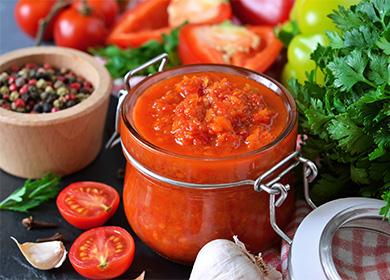Real oriental adjika is cooked only with rubber gloves - it has such a “burning” taste. And if the roasting-sharp mixture for direct consumption in food is not subjected to heat treatment, the billets for the winter are usually boiled, stewed on a stove, canned according to all the rules.
The composition, calorie content and benefits of spicy snacks
Sharp adjika is not a delicacy that "flies" instantly. They eat it by a teaspoon, spreading it on bread or bite, complementing the taste of roast, soup, side dish with aromatic seasoning. In the classic appetizer there are no tomatoes, as well as their inherent sourness, but there is plenty of pungency. The mixture is usually prepared in small jars with a volume of 250-350 ml so as not to spoil the contents with frequent opening.
The additive is considered low-calorie, contains 50-60 kcal, depending on the products used. The composition of the burning seasoning is represented by natural ingredients, the main of which are: hot chili peppers, garlic, salt and herbs. Often, the recipe is supplemented with walnuts, cilantro, hops, marjoram. The chemical composition is presented in the table below.
Table - Content in adjika of beneficial substances and vitamins
| Vitamins, mg per 100 g | Minerals, mg per 100 g | Other substances, g per 100 g |
|---|---|---|
| Vitamin C - 30 | Calcium - 9 | Water - 94.1 |
| Niacin - 0.6 | Phosphorus - 16 | Proteins - 0.9 |
| Folic Acid - 11 | Magnesium - 12 | Fats - 0.6 |
| Vitamin A - 0.02 | Potassium - 564 | Carbohydrates - 3.9 |
| Vitamin B - 0.14 | Sodium - 25 | Fiber - 0.7 |
| Riboflavin - 0.09 | Iron - 0.5 | Sugar - 2.55 |
| Thiamine - 0.01 | Zinc - 0.15 | Fatty acids - 0.41 |
The beneficial properties of spicy additives are manifested depending on what recipes adjika for the winter are used. Regardless of the composition, the supplement increases appetite, normalizes digestive processes and metabolism. The combination of garlic, hot pepper and seasoning has a healing effect on the body:
- strengthens the immune system;
- kills malicious viruses;
- activates blood circulation;
- improves the genitourinary system;
- increases potency;
- increases activity;
- strengthens blood vessels;
- saturates cells with oxygen.
Varieties
There are two types of sauce-like adjika - Abkhazian and Georgian. They differ in the composition of the ingredients, cooking methods and taste. A dry ready-made mixture is also isolated - ahkhyla, consisting of dried pepper, spices, garlic and spices. Such a “powder” is used for the preparation of marinades, spice soups, fish, and roast meat.
Abkhaz adjika comes in two forms.
- Red (apartpildzhika). Puree mass of red chili pods, walnuts, salt, garlic, savory seeds, dill, cilantro, basil. It is combined with fish and meat dishes, stewed vegetables.
- Green (ahushuajika). A thick mixture of unripe green burning pods, salt, a large number of aromatic herbs: dill, basil, mint, cilantro. It is used more often as a seasoning for snacks made from dairy products.
Georgian is conditionally divided into three types.
- Popular. Contains ripe hot and sweet red pepper, wine vinegar, cilantro, garlic.
- Simple. Includes, in addition to the above ingredients, juicy tomatoes and herbs.
- Piquant. It is prepared only from green burning pods and fragrant greens.
Adjika for the winter: the classic version without cooking
Features The classic adjika recipe (it is called "masculine") does not involve the thermal processing of ingredients. The additive is prepared from selected vegetables, chopped in a suitable way. The meat grinder allows you to maintain a bright color, but does not give the desired uniformity. A blender helps to obtain a homogeneous puree mass, but a lighter shade - due to grinding of seeds.
What to prepare:
- chili - 1 kg;
- garlic - 0.5 kg;
- grinding salt No. 0 - 150 g;
- aromatic herbs (dill, coriander, hops-suneli) - 100 g.
How to do
- Prepare vegetables: wash the pods, free from partitions and seeds, peel the garlic cloves. To dry.
- Grind the components in an affordable way. Chop greens with a knife.
- Salt, mix the components, wearing rubber gloves.
- Arrange the crude mixture in sterilized jars, store in the refrigerator or cellar.
Acute variations with and without preservation
Burning classical adjika is a close "relative" of Mexican salsa sauce; it has a similar pungent taste. Modern housewives supplement the traditional homemade adjika recipe with green and red tomatoes, beets, even pears, apples, experimenting with various additives and seasonings at their discretion.
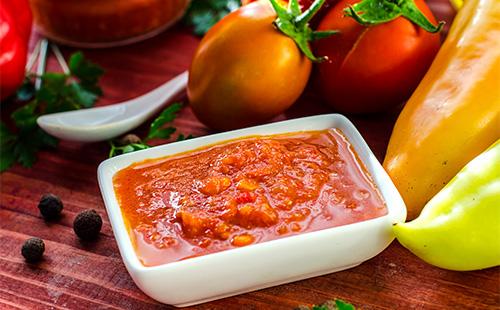
Abkhazian
Features The Abkhazian adjika recipe with nuts involves bringing the mixture to a boil, followed by rolling iron lids for the winter. The appetizer will have a spicy aroma, complement the taste of barbecue, meatballs, serve as a seasoning for manti, poultry, meat roast.
What to prepare:
- hot pepper - 0.5 kg;
- kernels of peeled walnuts - 100 g;
- salt - 100 g;
- ground coriander seeds - one and a half tablespoons;
- garlic - 150 g;
- cilantro - half a bunch;
- parsley - half a bunch.
How to do
- Dry the washed greens and pods, previously cleaned of partitions and seeds.
- Grind with a blender or meat grinder two to three times until an almost homogeneous mass is obtained.
- Fry the nuts in a dry frying pan, chop with a knife or mince.
- Mix all the ingredients, crush the garlic before this press, salt.
- Transfer the mass into a basin or pan, cover with gauze, leave it warm for three days. Stir a couple of times a day.
- On the fourth day, boil the mixture, immediately remove from the stove, arrange in dry banks and roll up for the winter.
In Georgian
Features The fiery seasoning in Georgian will delight you with its “vigorous” taste, piquant aroma of herbs, saturated with red color. Such an additive will arouse appetite, add a sharp touch to dishes of meat, fish, poultry, vegetable stew and soups. Salt for the recipe is suitable only for stone, coarse grinding. Iodized will cause fermentation and spoilage of the product.
What to prepare:
- hot chili - five pods;
- bell pepper - half the fruit;
- garlic - a whole head;
- fresh dill - one bunch;
- hops-suneli - two packs;
- dried coriander - one package;
- dried cilantro herbs - 20 g;
- salt - two teaspoons;
- walnuts - seven pieces;
- vinegar 3% - two teaspoons.
How to do
- Grind walnuts and coriander grains or grind into flour.
- Rinse prepared and peeled vegetables. Dry, then cut.
- Send into the blender bowl, chop, gradually pouring vinegar.
- Add chopped dill to the same place.
- Transfer the homogeneous mass into the basin, pour the crushed cilantro, spices, salt.
- Stir in gloves, adding mashed garlic, coriander and nut flour.
- Stir until butter is firm.
- Transfer to sterilized banks, cork.
In Bulgarian
Features Fragrant adjika in Bulgarian (another name - Lelya) will retain a beautiful look for a long time. The secret of rich color and long shelf life in the addition of aspirin. Pills will act as a kind of preservative, will not allow the workpiece to ferment.
What to prepare:
- tomatoes - 3 kg;
- sweet bell peppers - 0.5 kg;
- garlic - 250 g;
- hot chili - 250 g;
- aspirin (acetylsalicylic acid) - six tablets;
- salt - half a tablespoon.
How to do
- Remove septa, seeds from the pods, remove the stalks from the tomatoes, peel the teeth from the husks.
- Grind all the vegetables in a meat grinder.
- Pour in salt and powdered aspirin tablets.
- Stir, cover with gauze, soak at room temperature for seven to ten days, sometimes a couple of weeks.
- Arrange for banks, send stored in the winter for a refrigerator or basement.
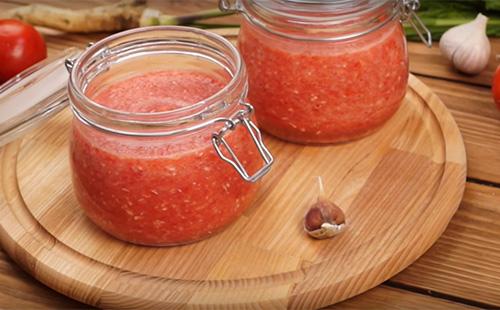
In Armenian
Features Armenian recipe with tomatoes is a variation on the theme “you will lick your fingers”. Here, there is a spice beloved by men, and a gentle tomato sourness, and the aroma of spicy greens. The workpiece is ready for use immediately after the fermentation process.
What to prepare:
- ripe tomatoes - 1 kg;
- chili - 100 g;
- garlic - 200 g;
- salt to taste.
How to do
- Prepare vegetables, remove stalks, seeds, partitions.
- Grind individually with a meat grinder. To connect.
- Add chopped garlic, salt and mix.
- Cover the pan with the vegetable mass with a piece of cloth, leave for two weeks for fermentation.
- Mix with a spatula every day.
- After the fermentation processes are complete, put the mass in dry clean jars and put in the refrigerator.
With eggplant
Features Winter preservation with eggplant will be popular with both men and women. The little blue ones will give adjika a piquant taste, slightly smoothing the sharpness, and give a beautiful look. Another plus of the appetizer is the speed of its preparation.
What to prepare:
- eggplant - 2.5 kg;
- tomatoes - 3 kg;
- bell peppers - 12 pieces;
- garlic - four heads;
- chili - two pods;
- salt - two tablespoons;
- sugar - one tablespoon.
How to do
- Peel all vegetables except eggplant from stalks, peels, seeds, and scroll through a meat grinder. To salt.
- Boil over low heat for ten minutes.
- At this time, peel the eggplant, cut into slices. Hold for five minutes in salt water.
- Grind the eggplant pieces, pour into the vegetable mass.
- Stir, cook for another hour.
- Remove from heat, pour into sterilized jars, tighten.
- Turn over the jars, wrap until cool.
- Remove cold adjika for storage.
No vinegar and sterilization
Features Adjika without vinegar for the winter will appeal to those who do not like the specific smell or taste of this preservative. In this recipe, the preservation of the workpiece is provided by horseradish rhizomes. Seasoning adds spiciness, piquancy and aroma to the spin.
What to prepare:
- tomatoes - 2.5 kg;
- garlic - two and a half heads;
- salt - 50 g;
- chili - half the pod;
- horseradish - three rhizomes.
How to do
- Pour boiling water over the tomatoes without stalks for three minutes.
- Rinse with cold water. Remove the skins.
- Peel the top layer from the horseradish rhizomes with a knife.
- In rubber gloves, peel the chili, remove the insides.
- Peel the garlic cloves.
- Grind all vegetables three times with a meat grinder, salt, mix.
- Arrange in sterilized jars, tightly cork, so that the workpiece does not dry out for the winter.
Green
Features Adjika from green bell pepper for the winter does not differ in taste from the same sauce from red fruits. However, it looks original, it allows you to surprise households and guests with an interesting composition. You can take any greens - parsley, mint, cilantro, dill, basil.
What to prepare:
- green bell pepper - 0.5 kg;
- chili - four pods;
- parsley - 200 g;
- dill - 100 g;
- cilantro - 50 g;
- garlic - 200 g;
- table vinegar - 50 ml;
- salt - one tablespoon;
- sugar - two tablespoons.
How to do
- Rinse the greens with water, dry, chop with a knife, and preferably turn into a pulp with a blender.
- Vegetables are also placed in a blender bowl, chopped. Mix with herbs.
- Salt, sweeten. Pour in the vinegar.
- Stir, arrange in banks.
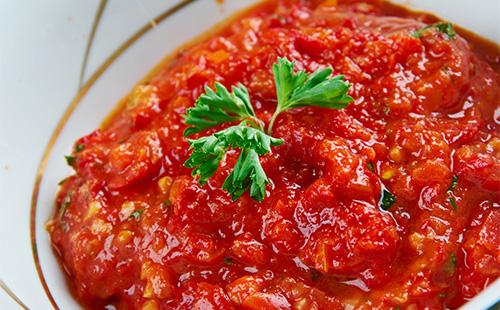
Boiled
Features Boiled adjika is kept longer fresh. Preservation “holds” the taste and aroma even after a couple of seasons after seaming. Garlic is laid after cooking - so the garlic smell lasts longer.
What to prepare:
- chili - four pods;
- table vinegar - 100 ml;
- garlic - four heads;
- tomatoes - 2 kg;
- sour apples - 1 kg;
- sweet bell pepper - 1 kg;
- horseradish - five roots;
- onions - 1 kg;
- carrots - 1 kg;
- salt - 150 g;
- sugar - 200 g;
- vegetable oil - 500 ml.
How to do
- Prepare vegetables, peeling, removing seeds, partitions. Rinse, cut into pieces.
- Scroll all slices in turn through a meat grinder, transfer the mass to a pan (except for garlic).
- Put on the stove, wait for boiling. Boil for about an hour.
- Add salt, sugar, pour vinegar and oil.
- Cook for another five minutes, turn off the heat. Add the garlic.
- Arrange on dry sterilized jars, tighten for the winter.
With mayonnaise
Features Classical adjika with mayonnaise will appeal to those who like to soften the spiciness with various additives. According to reviews, this seasoning is easily spread on sandwiches, goes well with side dishes, suitable for pizza, soups.
What to prepare:
- tomatoes - 3 kg;
- bell peppers - 2 kg;
- garlic - 200 g;
- pepper salt - one teaspoon;
- refined sunflower oil - one glass;
- table vinegar - 100 ml;
- dried dill - optional;
- mayonnaise.
How to do
- Grind tomatoes into porridge using a meat grinder or blender.
- Chop pepper into small pieces with a knife or skip it through a food processor.
- Combine the ingredients, boil for 40 minutes over medium heat.
- Remove from the stove, cool.
- Add seasoning, oil, salt.
- Add chopped garlic, mix.
- Combine with mayonnaise in a ratio of 2: 1 (adjika more than twice).
- Arrange in clean glass containers, tighten.
In a slow cooker
Features Using a slow cooker is a great way to save time when cooking. The main thing is to pre-measure the amount of vegetables, peel, rinse, chop them. Then you do not have to stand at the stove, constantly stirring the boiling mass.
What to prepare:
- tomatoes - 2 kg;
- red or orange bell peppers - 1 kg;
- garlic - 120-140 g;
- chili - two or three pods;
- sugar - three tablespoons;
- salt - one teaspoon;
- vegetable oil - half a glass;
- 9% vinegar is a third of a glass.
How to do
- Skip prepared Bulgarian pods and tomatoes through a meat grinder, pour the mass into a multicooker bowl.
- Pour in vegetable oil, sweeten, salt. Mix.
- Set the "Extinguishing" mode for an hour and a half. Cook with the lid closed.
- Periodically, once every half an hour, stir while opening the lid.
- In gloves, chopped peeled chili and garlic with a knife.
- After the signal, pour the ingredients into the bowl, pour the vinegar.
- Shuffle, set the "Extinguishing" mode for 20 minutes. Cook with the lid open to evaporate excess liquid.
- After the multwark signal, pour adjika into sterilized banks with a volume of 200-250 ml, roll up.
- Store up to two years.
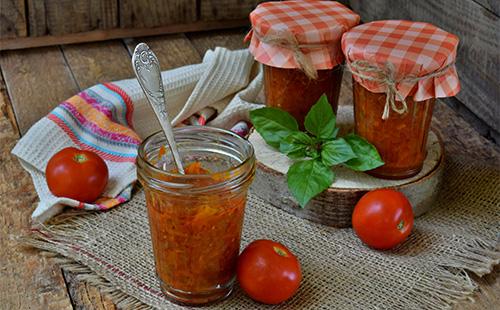
In the oven
Features Adjika from baked vegetables in the oven to taste and consistency resembles Italian pesto sauce. It goes well with spaghetti, pasta, steamed vegetables, easily spread on bread. Extra virgin olive oil and baked garlic add spicy dressing, chili - spicy.
What to prepare:
- red bell pepper - 500 g;
- dried tomatoes - 50 g;
- garlic - 100 g;
- olive oil - 250 ml;
- powder chili;
- ground pepper;
- salt.
How to do
- Pods, without peeling seeds, spread with garlic on a baking sheet.
- Bake in the oven at 170 ° C, remove and cool.
- Remove the peel, stalks, grind together with dried tomatoes and spices in a blender, pouring olive in parts.
- Stir, put into sterile jars with a volume of 200-250 ml.
Knowing how to cook adjika at home, it is easy to surprise the household and guests with seasoning “with a twinkle”. If desired, beets, pumpkins, plums, apples, mushrooms, even gooseberries or chokeberries can be added to recipes. Experimenting with tastes is not only possible, but also necessary.
Reviews
I don’t practically cook more than one second dish without adjika, I add it everywhere to soups and vegetables, and when I sing a chicken in the oven and barbecue can’t do without it, it’s a natural product from a mixture of peppers, the main thing is not to overdo it for those with a weak stomach .
Natasha http://vseotzyvy.ru/item/10613/reviews-adzhika/
There is no limit to the variety of recipes for cooking adjika. I myself prepare ten options for such adjika, because my husband loves very sharp adjika. I find it more neutral in taste, but I don’t give it to children at all. The constant ingredient in cooking adjika is garlic, coriander seeds and pepper. But the rest is man’s fantasies. You can add carrots, and tomatoes and zucchini, etc.
Ala Khabirova, http: //flap.rf/Food/Ajika? _ = 20
From childhood I remember how my grandmother cooked adjika and rolled cans with her for the winter. I really like her. In general, I just love spicy dishes, so I add it almost everywhere. She gives some piquancy to both meat and fish. Great supplement, actually.
Tatyana, http://vseotzyvy.ru/item/10613/reviews-adzhika/
Every year we cook adjika, though without rules, but to taste, take tomatoes, sweet peppers, hot peppers, garlic, horseradish root, salt, sugar, we determine the amount only according to my taste, do not pasteurize, store in the refrigerator, it’s calm until new harvest, though rarely gets tired, eat faster
Sergei, https://scastje-est.ru/adzhika-na-zimu.html
Other homemade recipes
Adjika plum
Adjika from zucchini for the winter
Homemade Chicken Stew
Pickled onion
